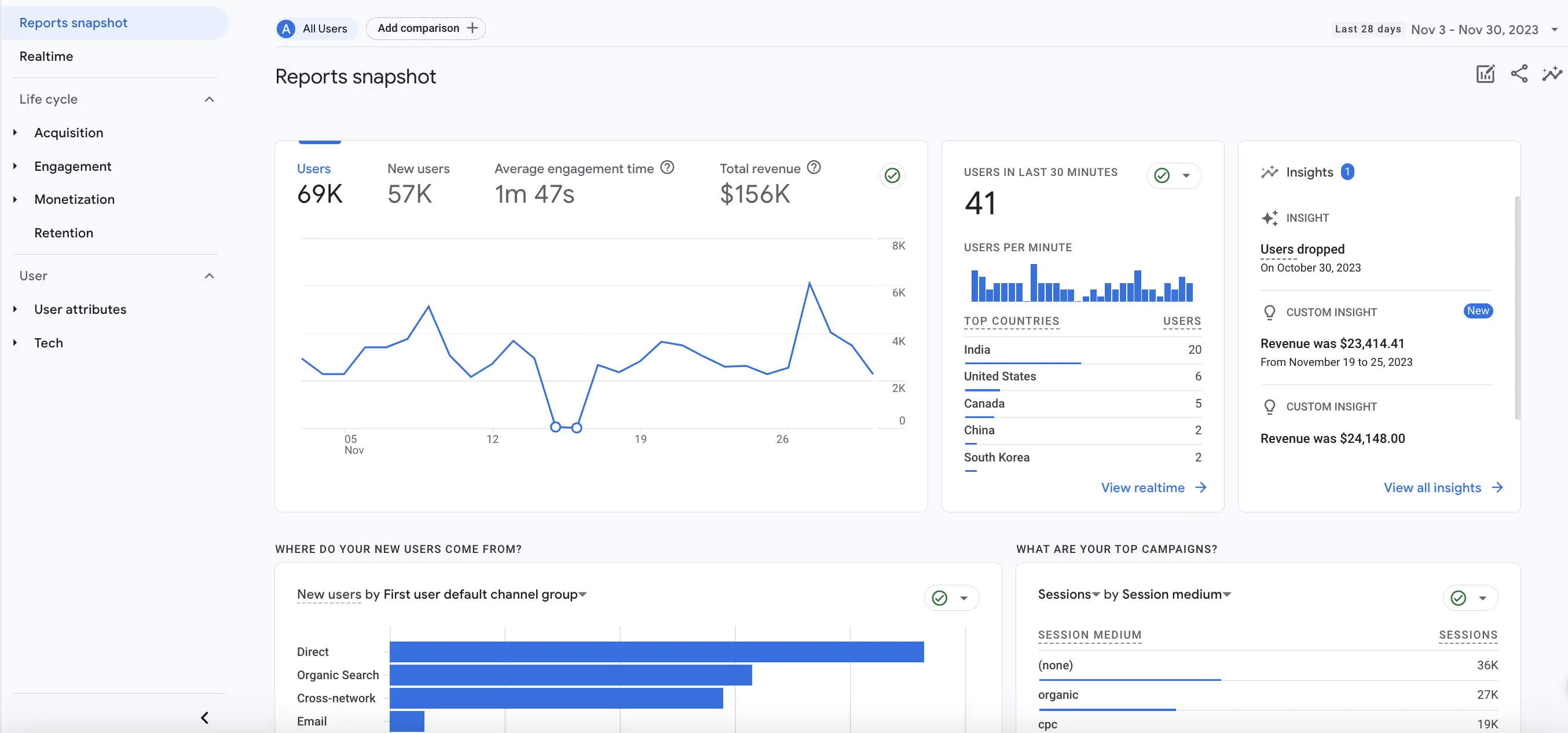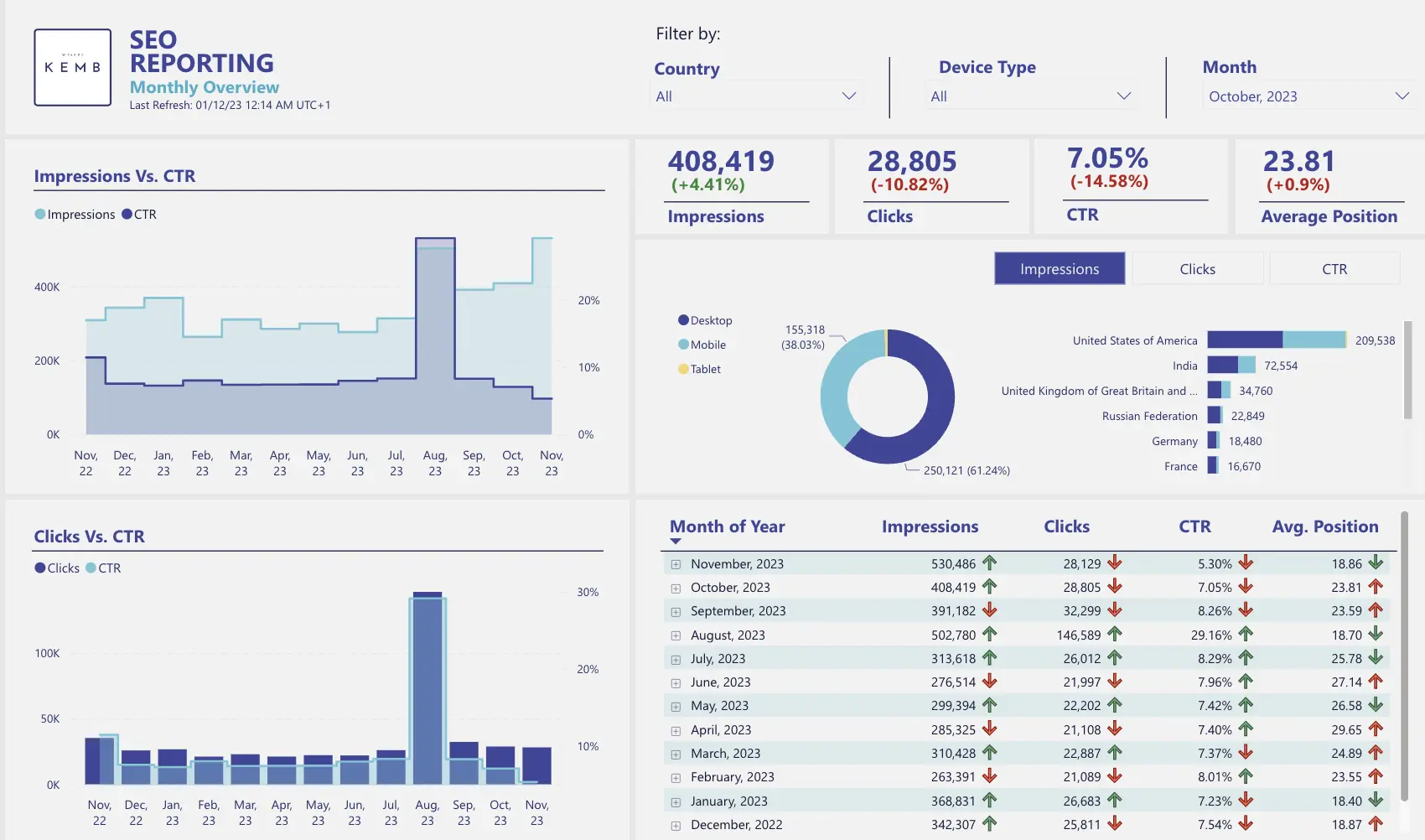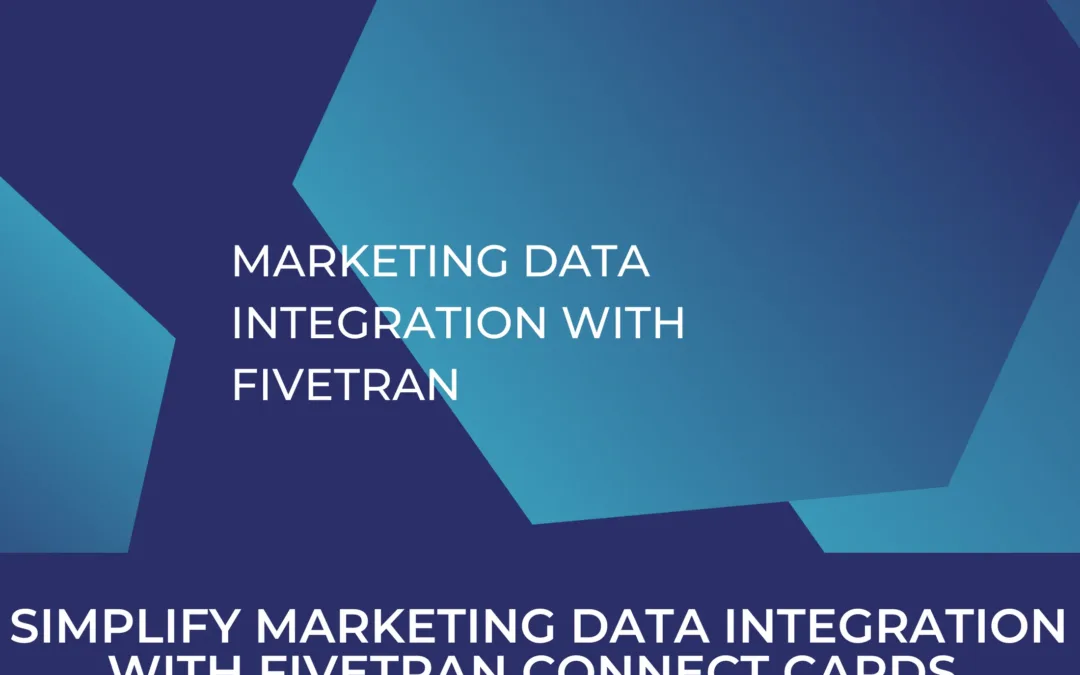Marketing Data Analytics: A lever for data-driven success
In this article, we will guide you through the most important aspects of Marketing Data Analytics you need to understand. We’ll guide you through practical insights on what you need to measure, the tools to leverage, and how you should strategically approach marketing analytics, providing actionable insights for your business intelligence infrastructure and enhancing your digital marketing strategy.
Table of Contents
Definition of Marketing Data Analytics
Marketing Data Analytics basically describes leveraging quantitative and qualitative data to gain insights into consumer behaviour, trends, and their preferences for informed marketing decisions. Businesses these days potentially have access to vast amounts of data. So marketing data analytics can play an integral role in seeking a competitive edge.
By analyzing various marketing metrics such as website traffic, social media engagement, customer surveys, and sales data, organizations can uncover patterns and trends that guide their marketing strategies. A data-driven approach allows companies to tailor their messaging, identify target audiences, optimize marketing campaigns, and ultimately, drive revenue growth.
Furthermore, marketing data analytics enable companies to measure the effectiveness of their marketing efforts, track return on investment, and make data-driven decisions to enhance marketing strategies.
Why? Understanding Your Customers Through Data-Driven Insights
Understanding your customers has become more critical than ever. Traditional marketing strategies are no longer enough to stay ahead. Instead, companies are turning to data-driven insights to gain a deeper understanding of their target audience. Marketing data analytics has emerged as a powerful tool in this regard.
By leveraging technology and marketing analytics tools, companies can uncover valuable insights about their customers, enabling them to tailor their marketing strategies to specific needs and preferences. From segmenting customer types to predicting future trends, marketing data analytics offers enormous possibilities for businesses.
Benefits of Using Marketing Data Analytics
Marketing data analytics provides several key benefits to companies.
-
It enables data-driven decision-making allowing businesses to make informed choices based on real-time insights. This not only increases the accuracy and effectiveness of their marketing strategies but also ensures that resources are allocated in the most efficient way possible.
-
Marketing data analytics improves return on investment (ROI) allowing to identify the most effective channels, messaging, and target audience for a company’s campaigns. By analyzing customer behaviour and preferences, businesses can optimize their marketing efforts, increase customer engagement and drive higher conversion rates and sales.
-
Customer retention: By tracking and analyzing customer data, businesses can identify customers that might churn to take action to retain them. This can include personalized communications, targeted offers, or customer loyalty programs, resulting in increased customer satisfaction and loyalty.
-
Structured campaign optimization: By continuously monitoring and analyzing campaign performance, businesses can identify areas for improvement and make data-based adjustments in real-time to improve e.g. response rates and therefore support a better return on investment.
-
Marketing data analytics provides a competitive advantage. By leveraging data insights, companies can stay ahead of trends, and outperform their competitors. For example, a retail company using data analytics might analyze customer purchase patterns to personalize marketing campaigns, enhance inventory management, and tailor promotions to specific segments.
-
Identifying trends: One way to identify trends from customer data is through the use of time series analysis. This method allows marketers to analyze data over a specific period of time, such as the frequency of customer purchases or website visits. By identifying patterns and trends in this data, marketers can make informed decisions about their marketing campaigns and promotions, optimizing their efforts for maximum impact.
-
Based on real customer insights, you can then take informed action on improvements in the customer journey, whether it be product features, streamlining processes, or enhancing customer service. The better you understand customer sentiments and needs, the more accurately you can tailor strategies to deliver personalized experiences, identify pain points, and improve offerings.
Overall, marketing data analytics is a powerful tool that enables businesses to make more informed decisions, optimize their marketing efforts, retain customers, and gain a competitive edge.
How: Collecting and Analyzing Customer Data
Collecting and analyzing customer data is an essential component of any successful marketing strategy. Of course, there are numerous sources of customer data available to businesses. These sources can include website analytics, social media insights, customer surveys, and CRM systems – all providing valuable insights into a target audience’s preferences, behaviors, and interests.

Examplary Report in Google Analytics 4
To efficiently collect and analyze customer data, various tools can be utilized. From data management platforms and customer relationship management systems to web analytics tools like Google Analytics and the like and social media listening tools. Bringing these sources together helps to gain a comprehensive and holistic view of customers. At kemb we support our clients with tailored solutions for a most effective setup.
High-quality data is crucial for effective marketing analytics. To ensure the data used for analysis is reliable and accurate, several steps and strategies need to be followed. Regularly updating and refreshing data sources is essential to maintain its accuracy and relevancy. Irrelevant data can overwhelm analysts and hinder effective decision-making.
The next important step lies in consolidating the data you gathered, where accuracy plays an important role to ensure error-free and consistent data quality across all sources. To address common causes of low-quality data, corrective measures need to be taken. This includes ensuring the correct usage of UTM tags for accurate tracking, setting up events and transactions correctly for precise data capture, and resolving issues with page redirects that may lead to data fragmentation.
Also make sure to maintain data security in compliance with regulations, integrate diverse sources for a comprehensive view, and focus on collecting relevant data aligned with business objectives. Conduct thorough data cleaning to eliminate duplicates and outliers, design for scalability in the future, and document processes for transparency.
Define clear data governance policies, fostering collaboration between teams to facilitate effective communication and a cohesive approach to data consolidation. From our many years of experience, we know that a clearly regulated process is critical for most efficient workflows within a team. All these aspects will help enhance the reliability and relevance of consolidated data for more impactful marketing analytics.
Automating the process of collecting and analyzing customer data offers several benefits. It saves time and resources by eliminating manual efforts in data collection and consolidation. Automation also ensures accuracy in data analysis, reducing the chances of errors and inconsistencies.
A lack of expertise can hinder companies from fully capitalizing on the power of data-driven decision-making. You need to make sure to bridge a potential skill gap by providing marketers with the necessary training and resources to gain technical knowledge in data analytics. Otherwise you may fail to identify emerging trends or understand the intricacies of consumer behaviors. Without the expertise to effectively harness your data, you risk falling behind competitors.
By evaluating every aspect of e.g. existing past digital marketing campaigns though, marketers can obtain a comprehensive 360-degree view of their customers. Examining past marketing efforts can provide valuable insights into what has worked and what hasn’t.
SEO Excellence awaits
Take the next step in enhancing your SEO strategy with Kemb’s SEO reporting dashboard!
Developing Effective Marketing Strategies Using Data Analytics
We have highlighted that companies can make data-driven decisions that are precise, targeted, and highly effective. Whether it’s optimizing marketing campaigns, identifying customer preferences, or uncovering new market opportunities in highly competitive marketplaces. Now let’s take another look at the steps to develop effective marketing strategies that deliver tangible results.
Goals and Tracking Progress with KPIs
Establishing goals and a proper tracking progress is maybe one of the most important aspects in marketing data analytics. This is where your Key Performance Indicators (KPIs) come into play.
A defined (though not set in stone) set of goals helps define what the organization wants to achieve and provide a roadmap. Through measurable objectives, marketers can identify areas that require improvement and track their progress along the way while KPIs act as the compass that guides them towards their goals.

Paid Performance Tracking using Kemb SEA Report
By focusing on specific metrics such as conversion rates, customer acquisition costs, or social media engagement, everyone in the team can align on the same goals which helps dramatically in the process. Moreover, you can easily and transparently measure the effectiveness of efforts and derive data-driven decisions to optimize strategies. Since with the huge amount of data available, it can be somewhat challenging to define the “best” ones for yourself. Best have a look at our article where we provide our recommendations on marketing KPI’s to track and explain how to properly measure them.
Without a clear understanding of your measurement goals, you risk collecting irrelevant data, wasting resources, and making decisions that do not positively impact your business outcomes. But by setting clear objectives, you’ll stay on track and make data-driven decisions that have a direct impact on the organization’s bottom line.
Your internal setup
Do not underestimate the importance of gaining a deep understanding of your organization’s data infrastructure, skill sets, and technological tools, since this is the starting point to your marketing data strategy.
An assessment helps identify potential gaps in data collection, storage, or analysis, allowing you to address limitations and make informed decisions about the resources needed for successful analytics implementation. Ask what types of data insights are feasible, ensuring that your analytics goals align with the available resources and technology within your organization.
This approach fosters a more efficient and effective implementation of marketing data analytics strategies. Reach out if you need support in this process.
Don’t forget benchmarks
Establishing a set of benchmarks to have an ambitious but still realistic reference point to assess the performance of your KPIs. Benchmarks offer insights into industry standards, competitors’ performance, or your own historical data, enabling you to contextualize your results.
By comparing your metrics to established benchmarks, you can identify areas of strength or weakness, set realistic performance expectations, and refine your strategies based on a broader understanding of the market landscape. This iterative process ensures that your goals are not only aligned with your internal objectives but also positioned competitively within the broader industry.
Collecting and analyzing your data
The process of collecting data for marketing data analytics typically involves identifying data sources, implementing tracking mechanisms, and leveraging tools such as web analytics platforms, CRM systems, or social media analytics. Utilizing tracking pixels, cookies, and custom parameters helps capture user interactions across digital channels.
We can only repeat it, data accuracy, consistency, and compliance with privacy regulations during the collection process should always be a focus aspect to allow for a reliable foundation for meaningful analysis and actionable insights. Regular monitoring and iterative analysis contribute to a continuous improvement cycle in marketing performance.
Iterate
The improvement process in marketing data analytics involves implementing changes based on the insights gained from analysis. This may include refining advertising strategies, adjusting targeting parameters, optimizing content, or realigning marketing channels. Continuous monitoring and ongoing adjustments ensure to stay agile and responsive to changing trends or customer behaviors by iterating and incorporating lessons learned from data analysis.

Examplary Event Tracking Overview in Google Analytics 4
Examples of marketing analytics
Onpage: Website
Web analytics focuses on analyzing and interpreting data related to website traffic and user behavior on your website. By utilizing various tracking tools and techniques, businesses can gather valuable insights into their online presence, user engagement, and overall website performance.
This type of analytics encompasses a wide range of metrics which can be further narrowed down per channel (like google organic, google ads, etc.), including page views, bounce rates, conversion rates, click-through rates, and average session duration, among others to improve overall website effectiveness.

Marketing Data Analytics using Kemb SEO Reporting
Attribution
Lead generation is a key aspect of marketing to identify and attract potential customers. It involves various strategies and campaigns to capture the interest of the target audience and convert them into leads. However, tracking and measuring the effectiveness of these lead generation efforts can be a challenge.
You need to measure which marketing efforts are most effective to optimize strategies and allocate resources.
For example with one of our clients that ran multiple marketing campaigns across different channels, by analyzing the data, we found that their email marketing campaigns were generating the most revenue and highest-quality leads.
With this information at hand, we had good reason to invest more in email marketing while saving money spend on e.g. paid search engine marketing as this turned out less effective of a channel and therefore improve the effectiveness of overall lead generation efforts.
Marketers can also use analytics to prioritize leads. Lead scoring models assign a numerical value to each lead based on factors such as demographics, behavior, and engagement. This helps businesses identify high-potential leads that are more likely to convert into customers.
SEO
SEO optimization can massively help improvea website’s organic search rankings and attract qualified leads. By analyzing data related to search engine optimization, businesses can gain helpful insights to optimize a website’s online presence and capitalize on opportunities.
One of the key benefits of SEO analytics is how it helps businesses understand their search rankings and identify improvement. By analyzing data on keyword performance, backlinks, and website traffic, companies can identify the keywords and phrases that a target audience is using to find your products or services. This information enables you to optimize the website’s content and and in turn improve your organic search rankings.
Additionally, SEO analytics provide businesses with data on the quality and quantity of website visitors they attract through organic search.

Kemb SEO Reporting: Top Performing Keywords and Significant Changes
At kemb we usually delve into a new client’s project by starting with a comprehensive SEO audit, to make sure the foundation of the page is in place. This is followed by a competitive analysis to identify necessary content basics, we identify gaps in the competition and derive a clear content strategy that enables the targeted creation of relevant content and content pillars to build out long term organic visibility that matches your audience’s demand. Feel free to reach out to us, we’re happy to support you in the process of establishing a proper organic strategy from scratch.
Offpage: Email marketing
Just another short example you should not forget when it comes to marketing analytics is of course your email strategy. One of the key metrics that can be examined through email marketing analytics is the open rate, which measures the percentage of recipients who actually open an email.
By analyzing this data, organizations can gauge the effectiveness of e.g. their subject lines, offering insights into which ones are captivating enough to catch recipients’ interest. Again, testing here can have a huge impact on the effectiveness of your campaigns. Through data based experiments, we’ve seen open rates double just by testing various types of speech in newsletter’s headlines.
Imagine you have an ecommerce store where your newsletter recipients already usually provide some of your top conversion rates. You can imagine the positive effect if you manage to get double the amount of people to read those in the first place.
All in all, tracking metrics such as open rate, click-through rate, and conversion rate, organizations can unlock valuable insights, optimize their email campaigns, and ultimately achieve greater success.
Social media
By analyzing data from platforms such as Facebook, Twitter, Instagram, TikTok or LinkedIn, you can gain further valuable insights into your audience’s preferences and behaviors. One of the key benefits is to measure audience engagement.
It enables businesses to track metrics such as likes, comments, and shares, providing a deeper understanding of how their content resonates with the target audience. This data can be used to optimize future content strategies, wether that is via social media again, or to be leveraged for your webite again to improve engagement.
Sentiment metrics are also essential component in this context. They allow businesses to gauge the overall sentiment expressed by their audience towards their brand or products. Positive sentiment can indicate successful marketing campaigns, whereas negative sentiment may signal areas for improvement.
Marketing data analytics TOOLS
Having the right tools at your disposal is key. From monitoring website performance to analyzing customer behavior, you’ll need the right set of tools at hand:
1. Website analytics tools: Tools like Google Analytics, Adobe Analytics, and Hotjar enable businesses to track website traffic, visitor demographics, and user behavior. They provide actionable insights to optimize web design and content.
2. Business intelligence and data visualization tools: These tools, such as Tableau, Power BI, or Metabase provide a comprehensive view of your marketing data. We cannot emphasize enough how important it is to visualize your marketing data well in the form of suitable dashboards. This really is maybe one of the most important steps to turn simple figures into actionable insights. To get a glimpse on what a proper visualization could look like, check out our SEO Reporting.
3. Social media analytics tools: With the rise of social media marketing, lots of data is provided to gain insights into social media performance, understand audience engagement, reach, perform sentiment analysis, and competitor benchmarking.
4. Marketing automation tools are extremely valuable too: HubSpot, and Mailchimp help streamline campaigns by automating tasks like email marketing, lead nurturing, and customer segmentation. They also provide valuable analytics to measure the effectiveness of your measures.
By leveraging these tools, businesses can unlock the true potential of marketing data analytics, gain a competitive edge, and drive business growth.
SEO Excellence awaits!
Take the next step in enhancing your SEO strategy with Kemb’s SEO reporting dashboard!
Conclusion: Leverage marketing analytics now
The significance of leveraging marketing data analytics cannot be overstated in today’s dynamic business landscape. The insights derived from data analysis empower businesses to make informed decisions, optimize strategies, and stay ahead of your competition.
From enhancing customer experiences to refining marketing campaigns and achieving measurable ROI, the potential of marketing data analytics serves as a cornerstone to achieve sustainable growth and to maintain an advantage in an increasingly data-driven environment.
Embracing this powerful tool not only drives efficiency but also positions businesses to navigate uncertainties and capitalize on opportunities for long-term success and at kemb, we provide the right tools for you to take the necessary steps and to build the necessary groundworks with you – from a proper BI infrastructure up to your data-driven marketing strategy. Feel free to reach out for support!





